英美概况之美国概况
英美概况之美国Unit1

The national flag
50 stars: 50 states 13 stripes: the f i r s t 13 states that used to be
colonies red: valor and hardiness white: innocence and purity blue: vigilance, perseverance and justice
The Central valley of Californ highly productive area basic field crops as sugar beets, beans, rice and cotton
Climate
The United States is mainly situated i the northern temperate zone.
Administrative States
· 50 states The largest in area: Alaska The second: Texas The youngest: Alaska and Hawaii
· Afederal district The District of Columbia Capital City: Washington
Yellowstone National Park
It covers an area of about 9000 sq.km.There are about 3,000 geysers and hot springs in the park.There are also other natural wonders.
Deep South
South Carolina Georgia Texas Alabama Mississippi Louisiana
英美概况--美国篇(终于找到了美国篇的全文)

英语国家概况第十三章美国地理位置Geography1.Alaska and Hawaii are the two newest states in American.Alaska northwestern Canada,and Hawaii lies in the central Pacific.阿拉斯加和夏威夷是最近加入美国的两个新州。
阿拉斯加在加拿大的西北部,夏威夷位邻中太平洋。
(本细节还有考“一句话简答”的可能)2。
The U.S has a land area of 9.3 million square kilometres.It is the fourth largest country in the world in size after Russia,Canada and China.就面积而言,美国是世界第四大国,就人口而言,美国是世界是第三大国。
3.Of all states of American,Alaska is the lagest in area and Rhode Island the smallest.But on the mainland Texas is the largest sate of the country.所有州中,阿拉斯加是面积最大的州,罗得岛最小,在美国大陆,最大的州是得克萨斯州。
4。
The Rockies,the backbone of the North American Continent,is also known as the Continental Divide.落基山脉是北美大陆的脊梁,也被成为大陆分水岭。
5。
The two main mountain ranges in American are the Appalachian mountains and the Rocky mountains. The Appalachians run slightly from the northeast to southwest and the Rocky mountains run slightly from the northwest to southeast.阿巴拉契亚山脉和落基山脉是美国的两座大山脉。
英美概况知识点总结归纳

英美概况知识点总结归纳英美概况是指英国和美国的文化、历史、政治、经济、教育等各方面的概况。
这两个国家在世界上具有重要的地位,对世界文化和政治产生了深远的影响。
下面将对英美概况的各个方面进行总结归纳。
一、文化概况1. 英国文化英国是一个拥有悠久历史的国家,其文化底蕴深厚。
英国文学自古至今在世界范围内具有重要地位,莎士比亚、狄更斯、奥斯丁等众多文学家的作品至今仍然备受人们喜爱。
英国音乐、戏剧、电影等领域也有着丰富的传统。
2. 美国文化美国是一个移民国家,因此其文化融合了来自世界各地的元素,呈现出多元化和包容性。
美国文学、音乐、电影等在世界上具有很大影响力,如杰克·伦敦、海明威、福克纳等作家的作品、爵士乐、摇滚乐、好莱坞电影等都深受人们喜爱。
3. 英美文化交流英美两国之间的文化交流十分频繁,互相影响。
英国音乐、戏剧、文学等在美国具有很大影响力,而美国的流行音乐、电影、文化现象也在英国广受欢迎。
二、历史概况1. 英国历史英国历史可以追溯到古代,罗马、盎格鲁-撒克逊、诺曼底人等不同民族和文化在英国留下了深远的影响。
英国从16世纪开始成为世界上的帝国大国,殖民了大量领土。
20世纪初,英国逐渐衰落,但仍然在政治、文化方面占有重要地位。
2. 美国历史美国历史相对年轻,但是却是一个充满传奇色彩的国家。
美国独立战争后成为独立国家,并在19世纪成为世界上最强大的国家之一。
20世纪,美国在两次世界大战后成为世界超级大国,对世界政治、经济产生了深远影响。
3. 英美历史关系英国曾是美国的殖民地,双方有着深厚的历史渊源。
美国革命后,两国保持了密切的关系,经济、文化、政治等方面有着广泛的交流合作。
三、政治概况1. 英国政治英国是一个君主立宪制国家,国家元首是君主,首相是政府首脑。
英国的政治体系成熟稳定,经过数百年的发展,形成了一套完善的议会制度和法律体系。
2. 美国政治美国是一个总统制国家,总统是国家元首和政府首脑。
美国概况知识点总结考研

美国概况知识点总结考研一、地理概况1. 地理位置:北美洲的中部,东临大西洋,西临太平洋,南与墨西哥、加勒比海和太平洋诸国相接,北与加拿大为邻。
2. 地形地势:美国地形多种多样,包括大平原、喀斯喀特山脉、罗基山脉、阿巴拉契亚山脉和阿拉斯加山脉等。
除了阿拉斯加和夏威夷,美国的大部分土地位于北美洲本土上。
3. 气候:美国境内的气候多样,包括亚热带气候、地中海气候、温带气候和寒带气候等。
南部的气候通常比北部更温暖,东、西海岸的气候也有所不同。
二、政治概况1. 政治制度:美国是一个联邦共和制国家,国会制为基础。
国会由参议院和众议院组成,行使立法权。
总统负责行政管理。
2. 政治体系:美国政治体系分为联邦政府和州政府,联邦政府和50个州政府之间有一定的自治和责任划分。
除了联邦政府和50个州政府外,还有特区政府和其他领土政府。
3. 政治党派:美国政治中的两大党派分别是共和党和民主党。
共和党通常主张保守理念,民主党则偏向自由派。
三、经济概况1. 经济体系:美国是一个发达的市场经济体,市场在资源配置中起主导作用,私有财产权得到保护,市场竞争自由。
政府在经济中的作用相对较小。
2. 经济结构:美国的经济结构非常多样化,包括农业、工业、金融和服务业等。
金融中心位于纽约,科技中心位于硅谷,汽车制造中心位于底特律。
3. 国民生产总值:美国是全世界最大的经济体之一,国民生产总值连续多年稳居世界第一。
四、文化概况1. 语言:美国的官方语言是英语,但由于移民的多样性,其他语言也得到了广泛使用。
2. 宗教:美国拥有多种宗教信仰,包括基督教、犹太教、伊斯兰教等。
相对而言,宗教信仰在美国社会中的地位比较重要。
3. 文化传统:美国的文化传统深受欧洲文化的影响,包括英国、法国、德国和荷兰等。
此外,美国的娱乐文化也有着世界影响。
五、教育概况1. 教育体制:美国的教育分为初等教育、中等教育、高等教育。
在高等教育方面,美国拥有世界一流的大学和研究机构。
英美概况_美国概况
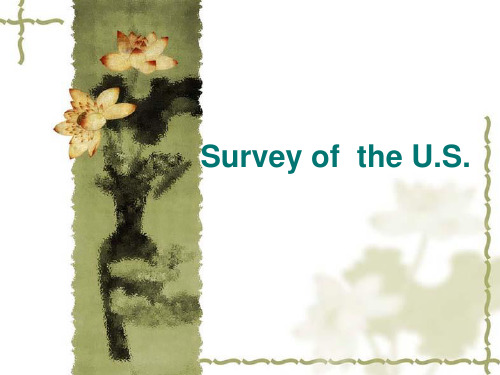
28
plex composition: 1) The native American 2) The white: 80% 3) The black: 4) Mexicans: 5) Puerto Ricans 6) Japanese, Philippines, Chinese…
29
2.The uneven distribution:
12
Topography.
13
Scenic spots in the west.
1. The Yellowstone National Park, Wyoming; 2. The Grand Canyon, Arizona; 3. Yosemite National Park, California; 4. Redwoods forests along the coastline; 5. The Death Valley, California;
6
The National Flag & Anthem
1. National Flag: the Star-Spangled Banner: Meaning: the 50 white stars the 13 stripes 2. National Anthem the star-spangled banner 《星条旗永不落》
16
The Atlantic System: 1) Hudson River 2) Dalaware River 3) the Potomac River 4) St. Lawrence River
17
The Pacific System: 1) Columbia River 2) Colorado River
英美概况大题知识点总结
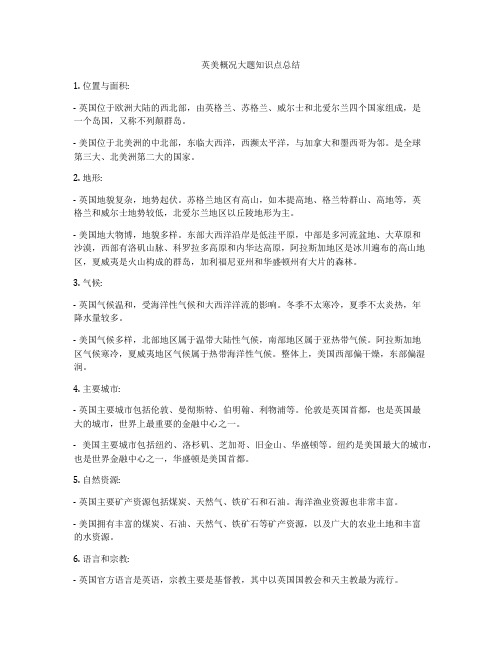
英美概况大题知识点总结1. 位置与面积:- 英国位于欧洲大陆的西北部,由英格兰、苏格兰、威尔士和北爱尔兰四个国家组成,是一个岛国,又称不列颠群岛。
- 美国位于北美洲的中北部,东临大西洋,西濒太平洋,与加拿大和墨西哥为邻。
是全球第三大、北美洲第二大的国家。
2. 地形:- 英国地貌复杂,地势起伏。
苏格兰地区有高山,如本提高地、格兰特群山、高地等,英格兰和威尔士地势较低,北爱尔兰地区以丘陵地形为主。
- 美国地大物博,地貌多样。
东部大西洋沿岸是低洼平原,中部是多河流盆地、大草原和沙漠,西部有洛矶山脉、科罗拉多高原和内华达高原,阿拉斯加地区是冰川遍布的高山地区,夏威夷是火山构成的群岛,加利福尼亚州和华盛顿州有大片的森林。
3. 气候:- 英国气候温和,受海洋性气候和大西洋洋流的影响。
冬季不太寒冷,夏季不太炎热,年降水量较多。
- 美国气候多样,北部地区属于温带大陆性气候,南部地区属于亚热带气候。
阿拉斯加地区气候寒冷,夏威夷地区气候属于热带海洋性气候。
整体上,美国西部偏干燥,东部偏湿润。
4. 主要城市:- 英国主要城市包括伦敦、曼彻斯特、伯明翰、利物浦等。
伦敦是英国首都,也是英国最大的城市,世界上最重要的金融中心之一。
- 美国主要城市包括纽约、洛杉矶、芝加哥、旧金山、华盛顿等。
纽约是美国最大的城市,也是世界金融中心之一,华盛顿是美国首都。
5. 自然资源:- 英国主要矿产资源包括煤炭、天然气、铁矿石和石油。
海洋渔业资源也非常丰富。
- 美国拥有丰富的煤炭、石油、天然气、铁矿石等矿产资源,以及广大的农业土地和丰富的水资源。
6. 语言和宗教:- 英国官方语言是英语,宗教主要是基督教,其中以英国国教会和天主教最为流行。
- 美国官方语言也是英语,宗教信仰多元,基督教、犹太教、伊斯兰教等都有一定的信徒。
英美历史概况:1. 古代历史:- 英国在古代分别由凯尔特人、罗马人、盎格鲁-撒克逊人和维京人等民族统治,1066年诺曼征服后建立了专制统治的王朝。
英美概况知识点总结 美国

英美概况知识点总结美国美国概况知识点总结1. 地理位置:美国位于北美洲的中央,与加拿大和墨西哥接壤,东临大西洋,西临太平洋。
2. 面积:美国是世界上第四大的国家,总面积约为9.83万平方公里。
3. 人口:美国是世界上第三大的人口国家,人口约为3.27亿。
4. 政治体制:美国是一个联邦制共和国,政治体制为总统制,国家元首为总统。
5. 首都:美国的首都是华盛顿哥伦比亚特区。
6. 经济实力:美国是世界上最大的经济体,国内生产总值(GDP)居世界首位。
7. 联邦制度:美国是一个由50个州组成的联邦制国家,每个州都享有一定的自治权利。
8. 文化多样性:美国是一个移民国家,拥有来自世界各地的不同种族和文化,因此其文化也非常多样化。
9. 科技实力:美国在航空航天、信息技术、医药和生物技术等领域处于世界领先地位。
10. 社会体系:美国拥有完善的社会保障体系和医疗保健制度,以及广泛的教育资源。
英国概况知识点总结1. 地理位置:英国位于欧洲大陆西北部,横跨大不列颠岛和爱尔兰岛东北部。
2. 面积:英国总面积约为24.12万平方公里。
3. 人口:英国是世界上人口密度最高的国家之一,人口约为6600万。
4. 政治体制:英国是一个君主立宪制国家,国家元首为君主,国家首相为政府首脑。
5. 首都:英国的首都是伦敦,也是英国最大的城市和金融中心。
6. 经济实力:英国是世界上经济实力较强的国家之一,拥有发达的金融、服务和制造业。
7. 文化传统:英国有着悠久的文化传统,包括文学、音乐、戏剧和艺术等领域。
8. 政治影响:英国是联合国安全理事会常任理事国之一,对国际事务有重要影响。
9. 教育体系:英国拥有世界一流的教育资源和大学,吸引了大量国际学生前来留学。
10. 社会福利:英国的社会福利制度完善,提供医疗保障、养老金和失业救济等项目。
美国和英国在政治、经济和文化等方面都有着自己独特的特点,对于全球事务具有重要的影响力。
这些国家的概况知识点总结可以帮助我们更好地了解它们的国情和影响力。
英美概况知识点总结

英美概况知识点总结英美概况是指英国和美国的综合概述,包括地理、历史、文化、经济等方面的内容。
以下将从不同角度对英美概况进行总结。
一、地理概况英国位于欧洲大陆西北部,包括大不列颠岛和北爱尔兰。
英格兰、苏格兰、威尔士和北爱尔兰是英国的四个组成部分。
英国是一个岛国,海洋对英国的经济和国际交流起着重要作用。
美国位于北美洲,东临大西洋,西靠太平洋,与加拿大和墨西哥为邻。
美国是世界第三大国家,拥有广袤的领土和多样的地理环境。
二、历史概况英国历史悠久,曾经是大不列颠帝国的核心。
英国是工业革命的发源地,对现代科技和工业发展做出了重要贡献。
美国的历史相对较短,于18世纪独立建国。
美国是一个移民国家,吸引了来自世界各地的移民,形成了多元文化的社会。
三、文化概况英国文化深厚,包括文学、音乐、戏剧等方面的成就。
莎士比亚、狄更斯、奥斯卡·王尔德等众多文化名人出自英国。
英国的摇滚乐、流行音乐也享誉世界。
美国文化的影响力也非常大,好莱坞电影、流行音乐、美式足球等都深受全球喜爱。
美国文学也有众多杰出作品,如马克·吐温的《哈克贝利·费恩历险记》和弗朗西斯·斯科特·菲茨杰拉德的《了不起的盖茨比》。
四、经济概况英国是世界上最发达的资本主义国家之一,金融业和服务业发达。
伦敦作为国际金融中心,具有重要的地位。
美国是全球最大的经济体,以市场经济为基础,拥有世界上最发达的科技和创新产业。
美国是世界上最大的农产品生产国和第二大制造业国。
总结起来,英美概况涵盖了地理、历史、文化和经济等方面的内容。
英国和美国都是世界上具有重要影响力的国家,对世界的发展有着重要的贡献。
两个国家在不同领域都有独特的优势和特色,值得我们进一步深入了解和学习。
英美概况知识点总结专升本

英美概况知识点总结专升本英美概况是指英国和美国的基本情况及相关知识的总结和概述。
英国和美国作为世界上最具影响力的两个国家之一,其政治、经济、文化等方面的情况对世界和全球化进程产生着重要的影响。
本文将从英国和美国的历史、政治、经济、文化、教育、社会等多个方面对这两个国家的概况进行总结。
一、英国概况1. 历史英国的历史悠久,可以追溯到几千年前。
公元前43年罗马帝国入侵英格兰,建立了罗马不列颠,标志着英国进入了历史时期。
在此后的几个世纪里,英国经历了盎格鲁-撒克逊、维京人和诺曼底入侵等一系列事件,形成了英国独特的历史文化传统。
2. 政治英国是一个君主立宪制国家,国家元首是英国女王。
英国议会由上议院和下议院组成,是英国的最高立法机构。
英国政府主要由首相和内阁组成,负责国家的日常管理和决策。
3. 经济英国是全球第六大经济体,其经济体系主要由资本主义制度组成。
英国的主要经济产业包括金融、制造业、科技、医疗保健和旅游业等。
伦敦是英国的金融中心,也是世界上最重要的金融中心之一。
4. 文化英国是全球文化的重要中心之一,拥有丰富的文化遗产和传统。
英国文学、音乐、戏剧和电影等领域都享有盛誉,许多作家、音乐家、演员和导演都在世界范围内备受尊敬。
5. 教育英国拥有世界上一些最著名的大学,如牛津大学、剑桥大学等。
英国的教育体系以高质量和多样化而著称,吸引着许多国际学生前来留学。
6. 社会英国的社会福利体系完善,保障了人民的基本权益。
英国是多元文化的社会,拥有来自世界各地的移民群体,形成了一个多元化和包容性的社会。
二、美国概况1. 历史美国的历史可以追溯到1492年克里斯托弗·哥伦布发现美洲大陆以来。
美国经历了移民潮、独立战争、内战、西部拓荒等一系列大事件,形成了美国独特的历史传统。
2. 政治美国是一个联邦制共和国,其政治体系基于宪法的原则。
美国总统是国家元首,由总统、参议院和众议院共同组成的三权分立制度是美国政治的核心特征。
(完整版)英美概况美国部分(修正版)
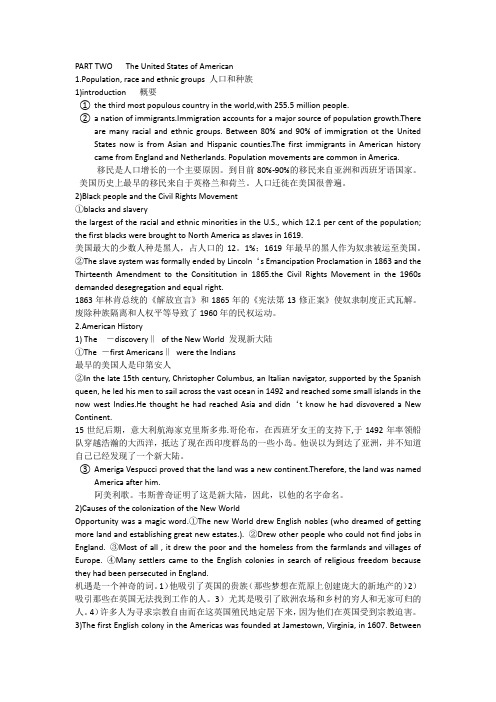
PART TWO The United States of American1.Population, race and ethnic groups 人口和种族1)introduction 概要①the third most populous country in the world,with 255.5 million people.②a nation of immigrants.Immigration accounts for a major source of population growth.Thereare many racial and ethnic groups. Between 80% and 90% of immigration ot the United States now is from Asian and Hispanic counties.The first immigrants in American history came from England and Netherlands. Population movements are common in America.移民是人口增长的一个主要原因。
到目前80%-90%的移民来自亚洲和西班牙语国家。
美国历史上最早的移民来自于英格兰和荷兰。
人口迁徙在美国很普遍。
2)Black people and the Civil Rights Movement①blacks and slaverythe largest of the racial and ethnic minorities in the U.S., which 12.1 per cent of the population; the first blacks were brought to North America as slaves in 1619.美国最大的少数人种是黑人,占人口的12。
英美概况之美国概况

C. With Atlantic Ocean on the east, Pacific Ocean on the west
D. Total area: 9372614
II. Three Geographical Divisions
1. The eastern part A. The highlands formed by the Appalachian
inland navigation and irrigation system
Mississippi River
2. The system of the Atlantic: no long rivers
A. the Hudson River, linked by canals with the five Great Lakes, a main artery for inland waterway traffic
6. 50 cm Rain-fall Line
V. Natural Resources
1. Rich in deposits, forestry, water power 2. First in: coal, natural gas, aluminum,
zinc, silver, molybdenum, uranium, zirconium 3. Large reserves: iron ore, phosphorus, copper, gold, Sylvite, sulfur 4. Short of: manganese, chromium, nickel, tin, cobalt, stibium, diamond, mica 5. ¼ of the territory is covered with forests. 6. Rich water power resources
英美概况美国部分(修正版)

英美概况:美国部分美国是一个世界强国,也是世界上最发达的国家之一。
它是全球第三大面积的国家,也是人口最多的发达国家之一。
在全球政治、经济、文化和科技等多个方面都具有重要影响力。
本文将介绍美国的基本概况,包括历史、政治、经济、文化等方面的信息。
历史美国的历史可以追溯到17世纪初。
当时,欧洲人开始在美洲殖民,最初的定居点之一是弗吉尼亚州的詹姆斯敦。
在接下来的几个世纪里,欧洲的殖民者不断向西扩张,逐渐控制了整个北美洲。
在18世纪末,美国独立战争爆发,美国成功地获得了独立。
之后,美国逐步成为一个强大的国家,经历了艰苦的内战、两次世界大战、冷战等重要时期。
如今,美国已经发展成为一个全球超级大国。
政治美国是一个联邦共和制国家,由50个州和华盛顿特区组成。
美国的总统是国家最高领导人,其它重要政治职位包括国务卿、众议院议长、参议院议长等。
美国的政治体系强调三权分立,即立法、行政和司法。
除了国家政府外,各个州和地方政府也有很大的自治权力。
例如,州政府负责管理其内部的基础设施、教育、警力等方面的事务。
经济美国是世界上最大的经济体之一,并拥有世界上最先进的市场经济体系。
其国内生产总值(GDP)约为21万亿美元,占据了全球总GDP的近四分之一。
美国的经济以服务业和制造业为主。
其中,科技产业是美国经济的一个重要支柱,硅谷和纽约市的科技企业在全球范围内都有重要影响力。
美国的贸易额也非常高,是世界上最大的进口国和第二大出口国。
文化美国文化是世界上最多元化的文化之一,其核心价值包括自由、民主和平等。
美国拥有世界最顶尖的大学、艺术机构和博物馆,其中包括哈佛大学、纽约大都会艺术博物馆、洛杉矶县艺术博物馆等。
美国的音乐和电影产业也非常有名,好莱坞电影更是成为了世界的一张名片。
在日常生活中,美国人非常注重个人隐私和自由,热爱户外运动和旅游。
他们吃的食物和所喜欢的体育运动都各具特色,如热狗、汉堡包、冰淇淋、棒球等。
美国是一个多元化的国家,拥有着丰富的历史、政治、经济和文化。
英美概况教程知识点总结
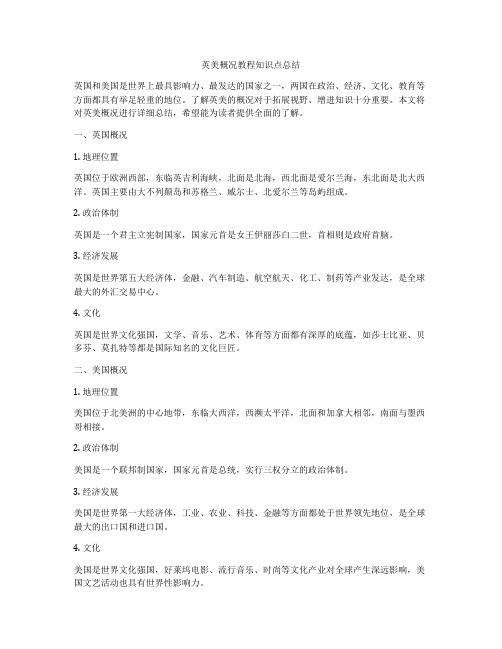
英美概况教程知识点总结英国和美国是世界上最具影响力、最发达的国家之一,两国在政治、经济、文化、教育等方面都具有举足轻重的地位。
了解英美的概况对于拓展视野、增进知识十分重要。
本文将对英美概况进行详细总结,希望能为读者提供全面的了解。
一、英国概况1. 地理位置英国位于欧洲西部,东临英吉利海峡,北面是北海,西北面是爱尔兰海,东北面是北大西洋。
英国主要由大不列颠岛和苏格兰、威尔士、北爱尔兰等岛屿组成。
2. 政治体制英国是一个君主立宪制国家,国家元首是女王伊丽莎白二世,首相则是政府首脑。
3. 经济发展英国是世界第五大经济体,金融、汽车制造、航空航天、化工、制药等产业发达,是全球最大的外汇交易中心。
4. 文化英国是世界文化强国,文学、音乐、艺术、体育等方面都有深厚的底蕴,如莎士比亚、贝多芬、莫扎特等都是国际知名的文化巨匠。
二、美国概况1. 地理位置美国位于北美洲的中心地带,东临大西洋,西濒太平洋,北面和加拿大相邻,南面与墨西哥相接。
2. 政治体制美国是一个联邦制国家,国家元首是总统,实行三权分立的政治体制。
3. 经济发展美国是世界第一大经济体,工业、农业、科技、金融等方面都处于世界领先地位,是全球最大的出口国和进口国。
4. 文化美国是世界文化强国,好莱坞电影、流行音乐、时尚等文化产业对全球产生深远影响,美国文艺活动也具有世界性影响力。
三、英美概况对比1. 政治体制英国是君主立宪制国家,国家元首是女王,政治体制稳定;美国是联邦制国家,国家元首是总统,实行三权分立的政治体制。
2. 经济发展英国虽然是世界经济体,但经济规模和实力与美国相比仍有差距,尤其在科技、金融等方面美国更为发达。
3. 文化影响英国和美国在文化领域都有世界性的影响力,但美国的文化产业更加发达,对全球的影响力更广泛。
四、学习英美概况的重要性1. 拓展视野了解英美的概况可以帮助人们拓展视野,了解世界上其他国家的政治、经济、文化等情况,增强对世界的认识。
英美概况知识点总结高中

英美概况知识点总结高中英美概况是指英国和美国两个国家的基本情况和特点的总称,包括国家地理环境、政治制度、经济发展、文化传统、社会风貌等多个方面的内容。
作为世界上两个最具有影响力和历史底蕴的国家,英美概况的了解对于增进我们对这两个国家的了解和认识具有重要意义。
下面将进行英美概况知识点的总结,以便于大家更好地了解这两个国家。
一、英国概况1. 地理环境英国位于欧洲大陆西北面,是一个由英格兰、苏格兰、威尔士和北爱尔兰四个国家组成的联合王国。
英国地处大西洋东部,地形多样,有山地、平原、丘陵和岛屿等地貌。
英国的气候受大西洋海洋性气候影响,冬季温和湿润,夏季凉爽多雨。
英国是一个发达的海岛国家,拥有丰富的自然资源和美丽的风景。
2. 政治制度英国的政治制度是君主立宪制,君主是国家元首,议会是最高权力机构。
英国议会分为上议院和下议院两个部分,议会具有立法和监督政府职能。
英国政府由内阁负责,内阁首相是政府首脑,由议会多数党派的领导人担任。
英国的政治体制稳定成熟,拥有悠久的历史传统和独特的民主制度。
3. 经济发展英国是一个发达的工业化国家,经济实力雄厚。
英国拥有发达的资本市场和金融服务业,是全球金融中心之一。
英国的经济以服务业为主,尤其是金融、保险、房地产、科技和娱乐等领域发展迅速。
此外,英国也拥有发达的制造业和农业,是世界上最重要的出口国之一。
4. 文化传统英国是文化名城,拥有丰富的文化传统和历史遗产。
英国文学、音乐、艺术、博物馆、剧院等领域都有重要影响力。
英国享有丰富多样的文化产业,包括电影、电视、出版、游戏等领域蓬勃发展。
英国还拥有众多世界知名的文化遗产,如巨石阵、温莎城堡、巴斯古城等。
5. 社会风貌英国社会多元包容,拥有多样的文化建制和生活方式。
英国是一个移民国家,吸引了来自世界各地的移民,形成多元的社会结构。
英国的社会福利体系完善,医疗、教育、社会保障等公共服务和福利都得到充分保障。
英国社会秩序良好,法治建设完善,民众享有相对安定和安全的生活环境。
英美概况知识点总结

英美概况知识点总结英美是指英国和美国这两个英语为官方语言的国家。
它们在政治、经济、文化等方面有许多共同点,同时也存在一些差异。
下面将从地理、历史、政治、经济、文化等方面对英美进行总结。
地理概况:英美两国都位于北美洲,但地理位置有一些差异。
英国是一个由大不列颠岛和北爱尔兰组成的岛国,位于欧洲西北部的大西洋上。
美国则位于北美洲的中北部,东临大西洋,西濒太平洋。
历史概况:英国是一个历史悠久的国家,拥有世界上最古老的君主制度。
英国曾经是世界上最大的殖民帝国,统治过许多地区。
美国则是一个相对年轻的国家,于1776年宣布独立,脱离英国殖民统治。
美国独立后逐渐发展成为世界上最强大的国家之一。
政治概况:英国是一个君主立宪制国家,国家元首是女王,但实际上的政府首脑是首相。
英国的政治制度相对稳定,以议会制度为基础。
美国是一个联邦制共和国,国家元首是总统,政府采取三权分立的制度。
美国的政治制度注重个人自由和权利保护。
经济概况:英国是世界上第六大经济体,拥有发达的市场经济和先进的金融体系。
主要经济领域包括金融服务、制造业、创意产业等。
美国是世界上最大的经济体,拥有高度发达的市场经济和先进的科技产业。
主要经济领域包括金融服务、制造业、科技产业等。
文化概况:英国是文化的发源地之一,拥有丰富的文化遗产和悠久的文学传统。
莎士比亚、狄更斯等文学巨匠都是英国的代表作家。
英国还有伦敦的剧院、博物馆等文化场所吸引着世界各地的游客。
美国是一个多元文化的国家,吸引了许多移民和不同文化背景的人。
美国的文化产业非常发达,好莱坞电影、流行音乐等在世界范围内有着广泛影响。
总结:英美两国在地理、历史、政治、经济、文化等方面都有许多共同点,同时也存在一些差异。
英国是一个历史悠久、文化底蕴深厚的国家,而美国则是一个相对年轻、多元文化的国家。
两国都在世界上扮演着重要的角色,对全球发展和影响具有重要意义。
美国课件3历史美国概况英语国家概况英美概况

❖ In 1632, he became the second Baron of Baltimore and the first Lord of Maryland.
Maryland
Decrees in Maryland
❖ Each gentleman brought 5 servants was allowed to establish a manor of 2000 acres.
Quakers
Quakers
American Beginnings
❖ The term “Quaker” was coined by their enemies because the Quakers were so faithful to God that when they spoke of God, they trembled.
Discovery
❖ In late 15th-century Europe, there was a great demand for spices, textiles and dyes from Asia.
❖ Christopher Columbus, a mariner from Italy believed that he could reach the Far East by sailing from Europe.
❖ One group of English Puritans crossed the Atlantic in the ship Mayflower and settled at Plymouth, Massachusetts in 1620. A much larger Puritan colony was established in the Boston area in 1630.
美国概况知识点总结
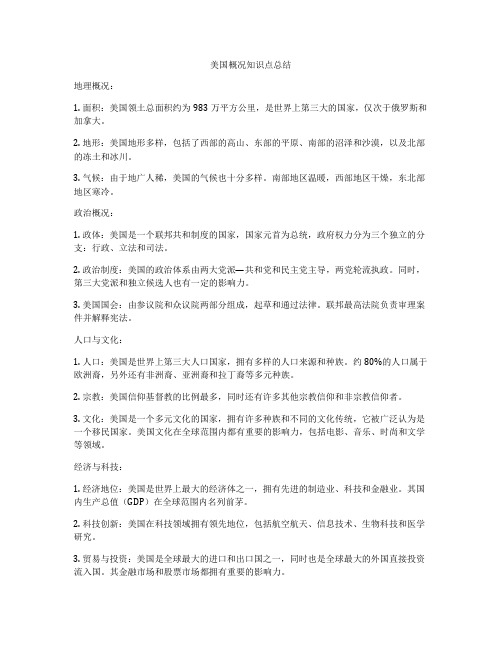
美国概况知识点总结地理概况:1. 面积:美国领土总面积约为983万平方公里,是世界上第三大的国家,仅次于俄罗斯和加拿大。
2. 地形:美国地形多样,包括了西部的高山、东部的平原、南部的沼泽和沙漠,以及北部的冻土和冰川。
3. 气候:由于地广人稀,美国的气候也十分多样。
南部地区温暖,西部地区干燥,东北部地区寒冷。
政治概况:1. 政体:美国是一个联邦共和制度的国家,国家元首为总统,政府权力分为三个独立的分支:行政、立法和司法。
2. 政治制度:美国的政治体系由两大党派—共和党和民主党主导,两党轮流执政。
同时,第三大党派和独立候选人也有一定的影响力。
3. 美国国会:由参议院和众议院两部分组成,起草和通过法律。
联邦最高法院负责审理案件并解释宪法。
人口与文化:1. 人口:美国是世界上第三大人口国家,拥有多样的人口来源和种族。
约80%的人口属于欧洲裔,另外还有非洲裔、亚洲裔和拉丁裔等多元种族。
2. 宗教:美国信仰基督教的比例最多,同时还有许多其他宗教信仰和非宗教信仰者。
3. 文化:美国是一个多元文化的国家,拥有许多种族和不同的文化传统,它被广泛认为是一个移民国家。
美国文化在全球范围内都有重要的影响力,包括电影、音乐、时尚和文学等领域。
经济与科技:1. 经济地位:美国是世界上最大的经济体之一,拥有先进的制造业、科技和金融业。
其国内生产总值(GDP)在全球范围内名列前茅。
2. 科技创新:美国在科技领域拥有领先地位,包括航空航天、信息技术、生物科技和医学研究。
3. 贸易与投资:美国是全球最大的进口和出口国之一,同时也是全球最大的外国直接投资流入国。
其金融市场和股票市场都拥有重要的影响力。
教育与医疗:1. 教育体系:美国拥有世界上一些最顶尖的教育机构,包括哈佛大学、斯坦福大学和麻省理工学院等。
其教育体系注重学生创造性思维和全面发展。
2. 医疗体系:美国拥有世界上最先进的医疗技术和设施,在医学和生物科技领域处于领先地位。
然而,其医疗保健体系在普及程度和效率上存在一些问题。
英美概况美国概况ppt教案

文化遗产:自由女神像、华盛顿纪念碑等
自由女神像
位于纽约港口,是法国送给美国 的礼物,象征着自由和民主。
华盛顿纪念碑
位于华盛顿特区,是为纪念美国 第一任总统乔治·华盛顿而建造的 ,高耸入云,是华盛顿特区的标
志性建筑之一。
独立宫
位于费城,是美国独立战争时期 的重要历史遗址,也是《独立宣
言》的签署地。
07
总统制
两党制
美国政治中主要有两大政党,即民主 党和共和党,两党通过竞选争夺总统 职位和国会席位,形成两党制的政治 格局。
美国实行总统制,总统是国家元首、 政府首脑和军队总司令,拥有广泛的 行政权和领导权。
主要政府机构及其职能
国会
总统及行政部门
国会是美国最高立法机构,由参议院和众 议院组成,负责制定法律和监督政府行为 。
科技创新为美国经济带来了显著的增 长动力,提高了生产效率和竞争力。
美国的科技创新涉及多个领域,如人 工智能、生物技术、航空航天等。
当前经济挑战及未来展望
美国经济面临着一些挑战,如财 政赤字、贸易不平衡、收入不平
等问题。
未来,美国经济将继续面临全球 化和技术变革带来的机遇和挑战
。
预计美国经济将保持增长动力, 但增速可能会受到国内外经济环
英美概况美国概况ppt教案
目录
• 引言 • 美国地理与历史背景 • 美国政治制度与政府机构 • 美国经济概况与发展趋势 • 美国社会文化与风俗习惯 • 美国旅游资源与推荐景点 • 总结回顾与课程考核
01
引言
教学目标与要求
01
掌握美国地理、历史、 政治、经济、文化等方 面的基本情况
02
了解美国的社会制度、 价值观念、生活方式等 文化特征
英美概况美国部分汇总整编

英美概况美国部分汇总整编AmericaThe Founding of Colonies殖民地的建⽴First Inhabitants:American IndiansDiscovery of the New World:1492 Christopher Columbus →the discoverer of America(Italian)Spanish Queen’ s support1501-2 Amerigo Vespucci →the new land was name after him as America.reached the mouth of Amazon RiverAmerica—the New WorldEurope—the Old World13 colonies:New England Colonies: Mid Atlantic Colonies: Southern Colonies:Massachusetts →(2nd colony,1620)New York MarylandNew Hampshire Pennsylvania Virginia →(1st colony,1607)Rhode Island Delaware North Carolina Connecticut South CarolinaGeorgia →(the last colony,1733)New England Region(6个): Massachusetts, Rhode Island, Connecticut, New Hampshire, Maine and Vermont建⽴原因:Virginia, 1607Virginia CompanyFor foreign expansion as a way of easing religious dispute and economic distress in England105 men (no women)Jamestown in honor of the kingMassachusetts In 1620102 Puritans (“Pilgrim Fathers”), in Mayflower, from Plymouth in England to AmericaFirst in Plymouth (today’s Massachusetts); and then BostonSeek religious freedomMayflower Compact <五⽉花号公约>:self-governmentHardships when arrivedthe help of the IndiansThanksgiving Day to thank the Indians and the God for protectionThe next three coloniesRhode Island, Connecticut, New HampshireReasons:1. religious disputes and struggles in Massachusetts intensified2. more immigrantsMaine and VermontReason: Proximity (邻近)Non-English ColoniesNew York, New Jersey were first colonized by the Dutch.Delaware was founded by the Swedish.Pennsylvania: Quakers /the Society of Friends (another group of English Protestant) William Penn, the founder Granted coloniesMaryland granted by Charles I to his friend Lord Baltimore as a refuge for English Catholics. South Carolina and North Carolina given by Charles II to his eight close supporters.The last colony GeorgiaA haven (港⼝,避难所) for English prisoners of debt who could not discharge their debts.The Early Immigrants最初的殖民与殖民⽣活White Anglo-Saxon Protestants (WASPs)Reasons to immigrate:1. religious disputes (persecute Catholics and Protestants)2. to become rich in the New World (Protestant work ethic)3. poor men as indentured servants(契约劳⼯)4. convictsAmerican culture:A blending of European cultures, but not a mere transplantation.New values:1. new ideas and reforms2. adaptations: less formal and more practical; less conservative and more outspoken3. industrious4. elasticity (弹性,灵活性),tolerance, compromise5. religion as a private affair6. liberty and democracyBoston Tea Party 波⼠顿倾茶事件Relation between England and ColoniesEconomic: supply England with raw materials while importing goods manufactured in England.England ←Rival; seven years war (1756-1763) →FranceProtection Make use of Indians to attack each other↓English colonies in America ←attack →Indians波⼠顿倾茶事件Cause: England allow the East India Company to undersell tea without paying import tax in the colonies.Place&Time:December 16, 1773, Boston harbor英国惩罚措施Intolerable Acts:ask to pay tea loss;to deprive self-ruleResult: This policy aroused the colonial opposition and they declared“no taxation without representation”.Two Continental Congresses 两次⼤陆会议1st Continental CongressSept. 5, 1774 in PhiladelphiaDelegates from 12 colonies except GeorgiaDocument: Declaration of Rights and Grievances 《权利和不满宣⾔》Rejected by the British ParliamentColonial militiamen were organized.The first armed clash (莱克星顿的枪声——导⽕索)April 19, 1775; Gunshots at the village Lexington, near Boston2nd Continental CongressMay 10, 1775 in Philadelphia, Independence HallOrganize and equip an American armyAppointing George Washington as commander-in-chiefAsk for help from other countries, esp. FrancePublic support: 1776, Thomas Paine published Common Sense and The American CrisisDeclaration of Independence独⽴宣⾔During the 2nd Continental Congress——A committee,(composed of Thomas Jefferson,Benjamin Franklin,John Adam and other members)To draw up the Declaration of Independence.It was drafted by Thomas Jefferson on July 4th, 1776(Independence Day / the National Day of the US)was a milestone in American history.It is remarkable in that it approaches the problem of American independence from the angle of human rights.“We hold these truths to be self-evident, that all men are created equal, that they are endowed by their Creator with certain unalienable Rights, that among these are Life, Liberty and the pursuit of Happiness; that to secure these rights, governments are instituted among men, deriving their just powers from the consent the governed; that whenever any form of government becomes destructive of these ends, it is the right of the people to alter or to abolish it, and to institute a new government...”--- Declaration of Independence, drafted by Thomas Jefferson, Benjamin Franklin, John Adams, etc..来源和评价:A masterpiece of western philosophy; mainly comes from the British philosopher John Lockeequality and freedomuniversal; beyond American boundariesMilitary Struggle and the Final Victory 战争经过和最后胜利England VS America 战前实⼒对⽐England Americapopulation: 10 m. 3 millionmost advanced not developedstrongest navy noneHigh morale-- Americans: high morale but repeated setbacksDifficulties:1. not every colonist support the revolution: loyalists such as big merchants and bankers2. the Continental Congress cannot pass laws and it did not have an executive branch to carry out the decisions3. lack money4. each colony is more concerned about defending itself than gaining independence as a whole5. lack the strength to fight against the British army.Turning point and the victories1.Surprise attacks游击战2.Franklin’ s diplomatic activities to obtain foreign aids, such as aids from France, Spain and Holland.3.French volunteers: e.g. LafayetteLast victory: Decisive battle at Yorktown led by WashingtonOn Oct. 19, 1781, British general Cornwallis (康沃利斯) surrendered.The final peace treaty The Treaty of Paris in 1783 acknowledged the American Independence.(The final peace treaty was signed in 1782 and went in effect in 1783)Constitutional Convention 制宪会议America Following Independencenew problems1) how to make use of the new territory--allow the founding of new states [equality and democracy]2) not very closely united--13 separate states rather than a united country3) economic difficulties-- trade problem with Britain--debts because of the Independance War-- increasing tax and Shays’Rebellion in MassachusettsThe need for a new Government was felt——May 25,1787,55 delegates from all states except Rhode Island attended the Constitutional Convention in Philadelphia. No easy work:the North vs the Souththe upper class vs lower classstate government vs central governmentThe draft of Constitution--completed on September 17, 1787--Constitutional Day of the USThe Father of the Constitution: James MadisonBill of Rights(1789): 10 amendments to the Constitutionfreedom of religion,freedom of speech and the press,the right of peaceful assembly and petition,the right to keep and bear arms,the right against unreasonable searches and seizures,the right against self-incrimination(⾃证其罪)---the right for everyone to refuse to give witness against himself in any criminal case.---a defense line against violations of human rights政治体制见另⼀张Territorial Expansion 领⼟扩张Washington as the First President 华盛顿执政期间April 6, 1789, Washington was elected as the First President by a unanimous vote in New York (provisional capital)1) success in transforming the states into a union2) Economy witnessed development"the first man in war, the first man in peace”Ways to Expand 四种领⼟扩张⽅式Purchase: Louisiana Purchase, Gadsden Purchase, Alaska Purchase, etcWar: Mexican War, Independence War, Spanish Cessions, etc.Annexation: Mexican Annexation, Hawaii Annexation, etc.Westward MovementJefferson and the Purchase of Louisiana 杰斐逊执政期间---third US President in 1801---emphasized development of agriculture and commerce---favored the westward expansionLouisiana Purchase, 1803其意义:1.doubled the territory of US and make possible further expansion2.put the Mississippi River system under the complete control of the US1) stimulate the agricultural and industrial development of the Midwest2)appearance of large cities as Chicago and Kansas CitiesThe Mexican War (1846-1848 ) 过程-- America claimed Texas, used to be part of the great Spanish Colony, was included in the purchase of Louisiana. -- In 1836, self-declaration of independence of Texas with many American Settlers from Mexico-- 1846, The Mexican War broke but finally an unequal treaty was forced on Mexico.Westward Movement 西进运动Expansion to the west (end of 18th- first half of 19th century)reason to move:1.small for increased population2.not satisfied with the present life3.American frontiersmen 拓荒者The most outstanding of all the westward migration took place after the war of 1812,there were many contributing factors:--the war 1812 drove the native Indians--the Federal government built roads and canals-- The Mississippi River opened and steam boat was invented in 1807.-- government policy: land for sale--the Homestead Act 宅地法(1862 President Lincoln)Cities:San Francisco,Portland,DenverThe significance and importance西进运动的重要性和影响-- Frontiersmen's InfluencePositive:on Politics:---Frontiersmen as presidents; Jackson, Lincoln and GrantExpanded territory and increased population laid the foundation for a global power.On Economicsfast development of agriculturefood surplus for tradecontribution to industrializationOn transportation and urbanizationOn American character and value---dash and daring, ready to run risks and aggressive---learn many skills and self-reliance, self-discipline---farmers and hunters , poor lower class; so not pay attention to social background---hard work: "work freaks", and "work addicts"---rough , pragmatic and less refined , honestNegative: Trail of Tears of IndiansThe beginning of Slavery in America 美国奴⾪制起源Reason: labor shortage in the coloniesTime: first in 1619 to plant tobaccoMethod: the triangular trade :carried out by the slave traders mainly from the New England by capturing Negros in west Africadevelopment and change:-- declined after Independence War-- revived when the American Industrial Revolution began in late 18th century.-- By 1860, 3 million Negro slaves; 1/3 of the Southern populationAmerican Civil War 南北战争/美国内战Conflicts arising from SlaveryReasons:-- Economically,north demanded the Congress to pass the protective tariff law--Politically,westward expansion: new land as free states or slave-holding states?--Religious and moral reason:slavery as inhuman and brutalDevelopment of the conflict1) abolitionists: to end slavery---secret organization to help slaves escape---mobilize public support2)the publication of Uncle Tom's Cabin (1852 Mrs. Stowe)(led to the outbreak of the American civil war⼀个⼩妇⼈的⼀部⼩书引起了⼀场战争)总结:Civil War爆发的原因:1.Political balance between the North and the South was broken2.Slavery inhibited the development of capitalism3.Some Christians opposed slavery for religious and moral reasons.Abraham Lincolna Republican; anti -slaveryOn March 4, 1861 President LincolnFirm in preserving the UnionMilitary Contest in the Civil War2 sides : the Confederate States of America (Confederacy) led by Davis and the Union led by Abraham Lincoln Attack On April 12, 1861 led by Fort Sumter, South CarolinaLincoln's goal: to defend the Union and defeat separatism分离论North Southadvantages: advantages:---larger population ---strong military tradition---loyal Navy ---experienced military officers---factories for munition production ---high morale---enough food supplydisadvantages: disadvantages:---poorly prepared ---smaller population---inexperienced soldiers ---not enough food supplyThe year 1863 was a turning point when the blockade stopped all foreign trade of the South.In July 1863, a great victory of the North in Gettysburg, Pennsylvania.Emancipation Proclamation, effective on Jan. 1, 1863Lincoln's Gettysburg Address: government of the people, by the people, for the people. 民有,民治,民享The Suffering of the South:men were killed, cities leveled to the ground, crops destroyedThe Union win the Final VictoryApril 2, 1865, Appomattox; Ulysses Grant (Union)vs. Robert Lee (Confederate)Effect of the Civil WarFinally put an end to slaverybut not really carried outKu Klux Klan (3K党):secret organization to threaten the black people.Economic development:Henry Ford in 1908Wright Brothers in 1903Telephone by Bill in 1876The lamp and motion picture by Thomas EdisonMonopolies 垄断公司The Standard Oil Company ,founded by John D. Rockefeller in 1870The United States Steel Corporation by Andrew CarnegieThe Bell telephone systemAmerica in and after WWI⼀战中和⼀战后的美国America before WWI (1914-1918)in the West: Latin America and the Caribbean were the backyard of it.In the East, the US advocated the Open Door Policy to guarantee its trade access.Military Blocs:Triple Alliance / Central Powers:Allied Entente:Germany BritainAustria-Hungary FranceItaly(后加⼊Allied Entente)RussiaAmerica (1917) On April 6,1917,the United States declared war on GermanyReasons of America to Join WarGerman submarines sank American shipsfear of Americans interests(huge loans made to Britain)Germany induced Mexico to war against AmericaAfter WWIPeace Conference in Paris in 1919the US president, Woodrow Wilson, put forward the Fourteen Points Plan, hoping to establish a new world order based on American values and ideals.Fourteen Points Plan unaccepted.The Americans shifted to isolationism.The Treaty of Versailles (American opposed to)The Roaring 20s("the jazz age")特点:Peaceful and prosperous"the jazz age"material consumptionspiritual frustrationIndustrial BoomBased on science and technologyMass production by assembly lines(car,movie,radio,chemical industries)Social Life: Womanhood as an Examplefirst wave of Feminist Movement for political and economic rightswomen's vote right was granted with the 19th amendment to the Constitution in 1920New Woman Image: job, bobbed hair, short skirts, lavish cosmetics, smoking and beauty contestsAmerican Values Corrupted by MaterialismThe Prohibition Law in 1919Spiritual Frustration: the Lost Generationlost American writersdiscontent with the existing social reality, but they did not know what to do about it."eat, drink, and be happy for tomorrow we shall die"The Great Depression 经济⼤萧条Mark标志: New York stock market crash on October 24, 1929[The bear market; “the black Thursday”]Results:BankruptcyShortage of money/ povertySharply reduced industrial productionStricken agricultureUnemploymentHomelessness: Many people had to live in dug-outs or tin-can shacks which were nicknamed Hoovervilles, a word derived from the name of President Hoover.EmigrationFranklin Roosevelt: a light in the darkness 罗斯福介绍Roosevelt selected as president in 1932.Family background: rich familyEducation background: Harvard Uni.Health: polio at 40; can't walk normallyPresident Roosevelt's “New Deal”罗斯福新政---presented to Congress more than 70 bills for approval, known as “New Deal”[新政]---1st: to pass the Emergency Banking Act---to enlarge employment and increase consumption---public projects: infrastructure---to raise the price of farm productsetc.Roosevelt's "Fireside Chat" 炉边谈话first "chat" on the radio to ask for confidence in the government and to return gold and money so as to reopen them.30 chats during the depression and the coming WWII.warmed, cheered, united people at that timeSignificance of New Deal 新政的重要性/影响---Roosevelt achieved some success in revitalizing American economy.---His New Deal strengthened the government regulation of economic activities and initiated the social welfare system in the United States.America in and after WWⅡ⼆战背景Background:The spread of Great Depression: Germany was the worst hit; led to Hitler’s fascist expansion. Time:Sept. 1939Mark: Germany’s invasion of Poland各国不同⽴场:---Russia-German nonaggression pact signed in Moscow in 1939---England and France: first, appeasement and nonintervention policy [by Munich Agreement], by selling other lands for peace [e.g. Sudetenland in Czech]; later, declared war on Germany when German army drove into France.Changes of US Stance:--- Neutrality from 1935-1937: 3 neutrality acts--- Pro-Ally policy from 1939: sell arms and munitions to belligerents on a “cash-and-carry”basis.--- Getting prepared for war from 1940 due to the deteriorated situation: the Roman-Berlin Axis [fascist military bloc]---Contribution to the war from 1941: Lend-Lease Bill [clever invention of Roosevelt]: any qualified countries could borrow or rent American weapons ---America is“the great arsenal of democracy”--- Entry into the war on Dec. 8, 1941: Japan’s air raid on Pearl HarborAmerica in the War:War-time economyConcentrated on the battlefields in EuropeSeveral million American soldiers诺曼底登陆(D-Day):June 6, 1944, known as D-day, the first contingents of American and British invasion army landed on the beaches of Normandy, opening the long-delayed western front to attack the Germans.Surrender of Japan ⽇本投降On August 6 and 9, 1945, American aircraft dropped two atom bombs on Hiroshima and Nagasaki in Japan, killing nearly 200,000 people. On August 14, Japan surrendered unconditionally and the WWII ended.America after the War-- Became a creditor nation-- Unemployment disappeared-- Dominant industrial production in the world and robust GDP-- Export monopoly in the world market-- Personal wealth accumulation and growing domestic marketA rising superpower and world leaderCold War and America in the 21st CenturyCold War (1945-1989)Cold war: the international tension, conflicts and containment without bloody hot war between Soviet Union and the U.S. Duration: end of WWII to the collapse of Berlin Wall in 1989Hot-spots热点地带:---Southern and Western Europe and Truman Doctrine, Marshall Plan;---Berlin Wall---Korean War---Vietnam War---Cuban Missile CrisisThe Truman Doctrine and the Marshall Plan 杜鲁门主义和马歇尔计划Stage 1:In Feb. 1947, Britain would end the economical support of Greece and Turkey, which would fall into the hands of the Soviet Union. America decided to help the two countries.Stage 2:The Truman Doctrine: President Truman’s speech to the Congress in Feb. 1949: the U.S. government would support any country which said it was fighting against Socialism.[real purpose]Stage 3:The worsening economic situation in Western Europe, coupled with a severe cold and snowstorm: might turn CommunistStage 4:The Marshall Plan (1947-1952): offer economic aid to Western economy; announced by Secretary of State (美国国务卿) George Marshall on June 5, 1947; $ 13 billionBerlin WallSoviet Union: block the West Berlin in June, 1948The U.S. : Airlift for food suppliesSoviet Union: Lifted the blockade in May, 1949.The foundation of NATO laterVietnam War (1955-1975)After 1970sIn 1980s, Reagan Revolution; Economic policy to counter against the inflation in 1970s:George Bush: Gulf War海湾战争Bill Clinton: Whitewater affair; Lewinsky ScandalAmerica in the 21st Century: terrorism and anti-terrorismGeorge W. Bush: Sept. 11th, Afghanistan War; Iraqi WarBarack Obama: new terrorismAmerican Political System美国政治体制:(Overview)The American Constitution---significancefounded federalism and introduced checks and balances(三权分⽴)into government for the first time in history—Based on division of power↓1.The First division of power-- federal governmentproblems of general concern e.g.to coin money, regulate commerce, raise an army and declare war, to make peace and treaties, levy taxes (征税)-- state governmentAll the powers not listed in the Constitution to pass state laws2.The Second division of power: check and balance system---three separate yet interdependent branches:The Executive (administration): presidentThe Legislative : the CongressThe Judicial: the Supreme Court, 11 courts of appeals and 91 district courts1)The Legislative : the Congress(535⼈)---the House of Representatives(435⼈,任期两年): in proportion to population---the Senate(100⼈,任期六年,三分之⼀的参议院席位每两年选举⼀次):2 Senators of each statethe Congress : make laws, levy taxes and money to cover government expenditure2)The Executive: Administration Headed by President总统任期四年,可连任⼀届the power of the President:to execute the law passed by theCongressto sign the act passed by Congress into lawto veto the bill passed by the Congressto appoint Federal Judges and Federal officials with the approval of the Senatein charge of the foreign policyCannot dissolve Congress while Congress cannot remove the President from office so long as he behaves well.总统选举——选举⼈团制度“胜者全得”制度(the winner-take-all System),即把本州的选举⼈票全部给予在该州获得相对多数普选票的总统候选⼈。
- 1、下载文档前请自行甄别文档内容的完整性,平台不提供额外的编辑、内容补充、找答案等附加服务。
- 2、"仅部分预览"的文档,不可在线预览部分如存在完整性等问题,可反馈申请退款(可完整预览的文档不适用该条件!)。
- 3、如文档侵犯您的权益,请联系客服反馈,我们会尽快为您处理(人工客服工作时间:9:00-18:30)。
3. The system of the pacific: two major rivers
6. 50 cm Rain-fall Line
V. Natural Resources
1. Rich in deposits, forestry, water power 2. First in: coal, natural gas, aluminum,
zinc, silver, molybdenum, uranium, zirconium 3. Large reserves: iron ore, phosphorus, copper, gold, Sylvite, sulfur 4. Short of: manganese, chromium, nickel, tin, cobalt, stibium, diamond, mica 5. ¼ of the territory is covered with forests. 6. Rich water power resources
C. Great Plains: western part D. Central lowlands: eastern part
most important agricultural area E. The Gulf Plain: low lands
III. The Three Major River Systems
inland navigation and irrigation system
Mississippi River
2. The system of the Atlantic: no long rivers
A. the Hudson River, linked by canals with the five Great Lakes, a main artery for inland waterway traffic
Range, relatively low. B. From north Maine to central Alabama, 1/6 C. consisting of the Piedmont Plateau,
Appalachian Plateau and Appalachian Range
Fall Line
The Appalachian Range
2. The western part
A. High plateaus and mountains by the Cordillera Range
B. From Canada to Mexico
C. Composed of the Coast Range, the Cascades and the Rocky Mountains
2. National flag
3. National emblem
4. The capital: Washington D.C.
5. The first president: George Washington
6. The 44th president: George W. Bush
7. National song: the star-spangled banner
The End
The colors of the flag are symbolic as well: red symbolizes Hardness and Valor; white symbolizes Purity and Innocence and blue represents Vigilance, Perseverance and Justice.
o say, does that star-spangled banner yet wave o'er the land of the free and the home of the brave? on the shore dimly seen thro' the mists of the deep, where the foe's haughty host in dread silence reposes, what is that which the breeze, o'er the towering steep,
❖ The national seal depicts the bald eagle with its wings spread, with one claw clutching an olive branch, and the other claw grasping arrows.
Back
oh, say, can you see, by the dawn's early light, what so proudly we hail'd at the twilight's last gleaming? whose broad stripes and bright stars, thro' the perilous fight, o'er the ramparts we watch'd, were so gallantly streaming? and the rockets' red glare, the bombs bursting in air, gave proof thro' the night that our flag was still there.
on the south.
C. With Atlantic Ocean on the east, Pacific Ocean on the west
D. Total area: 9372614
II. Three Geographical Divisions
1. The eastern part A. The highlands formed by the Appalachian
1. The system of the gulf: the Mississippi River:
A. the longest ,the most important river B. 6262 kilometers long from Great Lakes to the
Gulf of Mexico C. “father of waters” or “old man river” D. its tributaries form chain
Columbia Plateaus
valley
The great basin
Second chain
Colorado plateau
3. The great central plain A. landmass between the Rockies and the
Appalachians, ½ of America B. From the Great Lakes to the Gulf of Mexico
Lake Huron
Lake Erie
B. Great Salt Lake (largest inland salt lake in North America)
C. Niagara Falls: located on the U.S.A. Canadian boundary between Lake Erie and Lake Ontario
3. western: days are hot and nights are cool, dry, little rain
4. northeast: hot in summer, cold in winter, much rain and snow
5. Central plain: hot in summer, cold in winter, much snow
IV. Climate
1. On the whole:
A. Varies from coast to coast
B. Temperature from -20 to 25
C. Continental or mild subtropical
2. South & southwest: warmer, moist air
Part One Geography
Chapter I
A General Introduction to Physical Geography
I. Basic Information about America
1. Official Name: The United States of America
thirteen horizontal stripes, seven red alternating with 6 white
The stripes represent the original 13 colonies, and the 50 stars represent the 50 states of the Union.
A. Lying between the boundary of Canada and the United States
Lake Michigan (wholly within the United States) Lake Superior (the largest freshwater lake in the world)
Back
❖ In 1782, US Congress selected the bald eagle as the emblem of the newly formed United States, because it symbolizes courage and might, and because it is indigenous only to the United States and to Canada.
